Our umeboshi are made using only the finest Kishu Nanko-ume and other Kishu-grown ume.
In recent years, we have also focused on organic cultivation at our own farms in pursuit of even better taste and peace of mind.
All of the ingredients used in our wide variety of umeboshi are carefully selected.
The ume are grown in the best region in Japan, with abundant sunlight,
well-drained soil, mild climate, and mineral-rich sea breezes carried by the Kuroshio Current.
Wakayama produces 70% of Japan’s ume harvest.
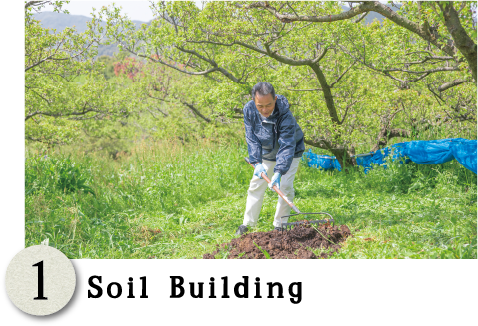
Compost is applied to the orchard to improve the soil for ume cultivation. It also maintains the health of the trees, stabilizes crop yield, improves water retention, and protects the roots from drying out.

Seeds from the best ume trees are planted in the field and grown for two years. A branch of another superior tree is grafted onto the base of the young tree. This process results in a sapling that will produce plentiful fruit.
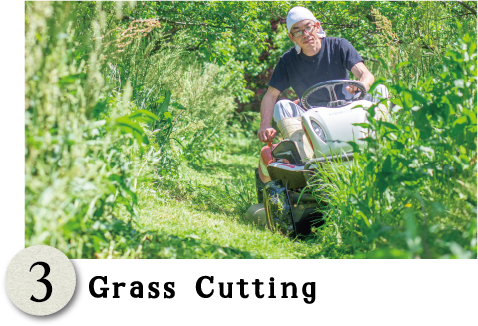
Weeds play a role in preventing the soil from drying out and maintaining its softness, but they also require proper mowing. At our garden, we cut the weeds in the orchards every April and September.

Pruning is carried out from November to January each year. We do it to control the shape of the tree and improve sunlight and air circulation.

Nanko-ume cannot self-pollinate and require pollen from different ume varieties. We create an environment conducive to cross-pollination by planting trees of different variety and also by grafting.

We bring beehives into the orchard in February, the time of flowering. Honeybees do the cross-pollination for us. The lowest temperature at which bees are active is around 8°C, and the weather at the time of flowering has a great influence on the year's crop.

Ume are a delicate fruit, and easily affected by pests and disease. To protect them, we use the minimum amount of chemicals necessary, which is about half of conventional methods. We also engage in approved special cultivation methods and organic farming.

Only ume that have ripened on the tree and fallen naturally are used for umeboshi. In order to prevent damage from falling and insects, we spread nets under the trees during the harvest season.

The harvest season lasts about a month from early June to early July. The ume ripen on the trees, turn yellow, and fall naturally.

自然が育ててくれた梅の実を格別な梅干へ仕上げるため、 職人たちの経験と勘を頼りに、すべての工程で丁寧な作業を心がけています。

During the harvest period, from early June to early July, the ume orchard is covered with blue nets under the trees. The fruits ripen on the trees and fall naturally, and are collected by hand daily.
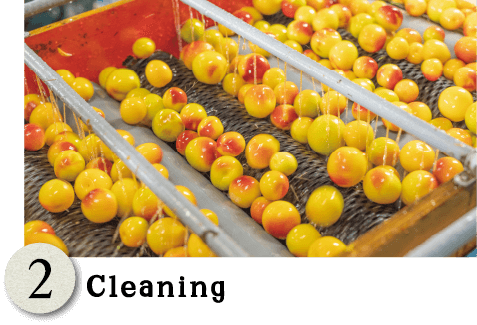
After harvesting, the fully ripened ume are thoroughly washed and then sorted by quality and size, with each ume checked by the craftsman's eyes. They are then soaked in water for about 30 minutes to remove any insects.

Next we pickle the ume in salt. Ume and salt are layered in the tanks in the amount that will bring the salt content to 20%. After that, we place weights on the ume and leave them for about a month.
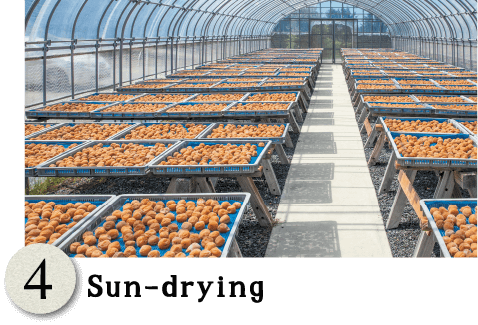
Then the ume are dried in the sun from around August. In order to ensure that all the ume are evenly dried, we turn and reposition them according to the color and condition of the skin. The experience and intuition of the craftsmen are put to good use here.
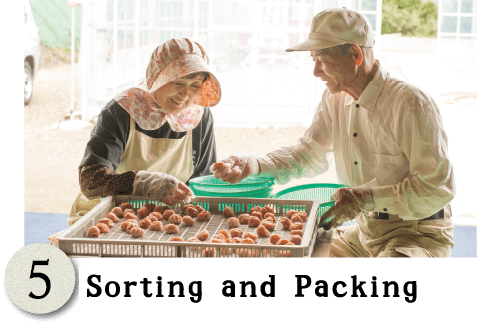
The dried fruits now look more like umeboshi. In order to maintain their visual quality, they are sorted by size and grade and packed carefully in barrels for storage.

When they come out of storage, the umeboshi are washed again and desalted for about half a day. After that, we soak them in a flavoring liquid unique to each product. The flavoring liquid is handmade with carefully selected ingredients to ensure a good fit with the ume.

Seasoning is done for a minimum of 18 days. During this time, each tank is inspected at least three times to ensure that each flavor meets the prescribed values. Since the taste will vary depending on the batch of ume fruit, strict adjustment is essential.

Next the umeboshi are packaged into their product containers while we again confirm the quality and size of each individual ume manually. The thin skin of Nanko-ume requires gentle and careful filling.
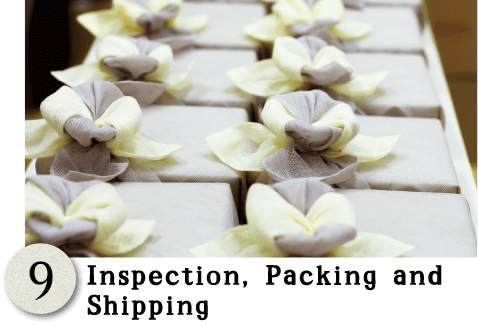
Finally we label the containers and pack them according to their intended use, such as for home use or for gifts. Then we send them to the customer's doorstep!

No synthetic pesticides, fertilizers, or herbicides are used.
The authentic taste of ume.


We use only ume from our own farm, Hamada Farms. Please enjoy the simple yet profound traditional ume.

| Calories | Protein | Fats | Carbohydrates | Salt equivalent |
|---|---|---|---|---|
| 39kcal | 0.8g | 0g | 9.0g | 20.3g |

*Certified as organic food by the Ministry of Agriculture, Forestry and Fisheries of Japan and by the Wakayama Organic Certification Association (WOCA).
Our original cultivation method starts with soil building.
The unique taste of Ishigami's land.
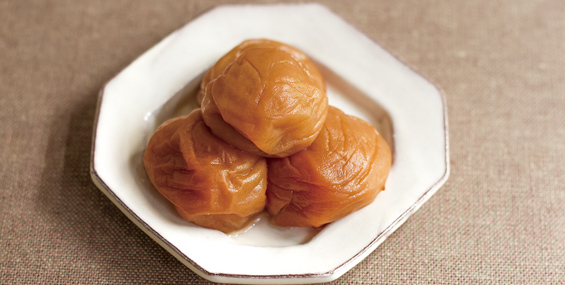

Kojo cultivated ume are pickled in salt and finished with black vinegar and five-grain vinegar to create this slightly sweet umeboshi.

| Calories | Protein | Fats | Carbohydrates | Salt equivalent |
|---|---|---|---|---|
| 103kcal | 0.5g | 0.1g | 26.1g | 5.28g |
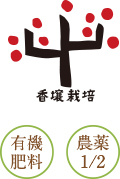
(1) No herbicides or chemical fertilizers are used.
(2) Made from specially cultivated ume certified by Wakayama Prefecture.
Our craftsmen carefully selected ingredients to get the best flavor from this gift of nature.
We create a wide variety of flavors. From traditional flavors to exciting new ones, we offer an extensive lineup,
including low-sodium and sweet umeboshi.


Only Kishu-grown ume with beautifully matched taste and shape are used. It has reduced salt with mild acidity and a hint of sweetness.

| Calories | Protein | Fats | Carbohydrates | Salt equivalent |
|---|---|---|---|---|
| 95kcal | 1.4g | 0.1g | 23.3g | 8.13g |


The gentle sweetness of Kishu Nanko-ume soaked in honey is great for those who prefer less sourness.

| Calories | Protein | Fats | Carbohydrates | Salt equivalent |
|---|---|---|---|---|
| 81kcal | 0.8g | 0.1g | 19.1g | 5.1g |


Dessert-like umeboshi soaked in the juice of local Unshu mandarin oranges. They taste even better cold.

| Calories | Protein | Fats | Carbohydrates | Salt equivalent |
|---|---|---|---|---|
| 119kcal | 0.6g | 0g | 29.2g | 4.88g |


A masterpiece using extra-large Nanko-ume. The umami of kelp and the sourness of ume create a compelling flavor.

| Calories | Protein | Fats | Carbohydrates | Salt equivalent |
|---|---|---|---|---|
| 99kcal | 1.0g | 0.2g | 24.1g | 7.82g |


This one features a mild flavor with a low acidity, covered generously with special flakes of Japanese red shiso (perilla) and bonito flakes.

| Calories | Protein | Fats | Carbohydrates | Salt equivalent |
|---|---|---|---|---|
| 95kcal | 0.9g | 0g | 24.4g | 8.43g |


Japanese red shiso leaves are carefully hand-rubbed. The squeezed juice of the leaves gives this umeboshi a bright red color and a delicious aroma and natural flavor.

| Calories | Protein | Fats | Carbohydrates | Salt equivalent |
|---|---|---|---|---|
| 20kcal | 0.7g | 0.1g | 6.5g | 13.28g |


Elegant bite-sized small Kishu-grown umeboshi. Perfect for onigiri rice balls and bento lunches.

| Calories | Protein | Fats | Carbohydrates | Salt equivalent |
|---|---|---|---|---|
| 18kcal | 0.7g | 0.1g | 6.1g | 13.36g |


This traditional umeboshi is made from only ume and salt. Enjoy the mild flavor and eye-opening acidity.

| Calories | Protein | Fats | Carbohydrates | Salt equivalent |
|---|---|---|---|---|
| 29kcal | 0.9g | 0.1g | 8.5g | 22.3g |

This size chart is only a rough guide to size and weight.
*Photographs may differ from actual sizes.